Here you’ll find information to help you live more successfully with hemophilia. From staying active and healthy to managing bleeds, it’s all easier when you know what to do and are prepared to do it.
Tips to help you navigate your hemophilia journey.
Tips to help you navigate your hemophilia journey.
Here you’ll find information to help you live more successfully with hemophilia. From staying active and healthy to managing bleeds, it’s all easier when you know what to do and are prepared to do it.
Bleed management = healthier joints.
Bleed management = healthier joints.
Joint bleeds cause damage to your joints that gets worse over time, causing pain and reducing your range of motion. Eventually, permanent damage can occur. That’s why it’s so important to stay on top of bleeds.
Managing bleeds.
Managing bleeds.
The best way to manage bleeds for yourself or your child is to be prepared. The more you know about how to notice a bleed, the quicker you will be able to treat it. You should also work with your hemophilia treatment center (HTC) to make a plan before bleeding occurs so you’ll know exactly what to do when it does.
Can you recognize an internal bleed?
It can be difficult to tell an internal bleed is occurring. Here’s what to look out for:
• Bruising, with or without lumps
• Swelling
• Difference in size of arms/legs
• Difference in movement of arms/legs
• Numbness .
• Weakness
• Tenderness
• Tingling
• Tightness
• Pain
• Warm skin
• Ache
• Dizziness
• Headache
HEMOPHILIA FACT
Bleeds can occur internally into joints and muscles or externally from minor cuts, dental procedures, or trauma.
Bleeds can occur internally into joints and muscles or externally from minor cuts, dental procedures, or trauma.

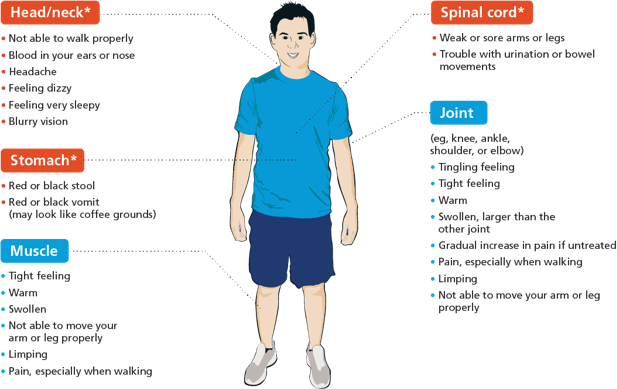
*NOTE: Bleeds are especially serious in head, neck, spinal cord, and stomach. If you have these symptoms contact your doctor immediately.
*NOTE: Bleeds are especially serious in head, neck, spinal cord, and stomach.
If you have these symptoms contact your doctor immediately.
*NOTE: Bleeds are especially serious in head, neck, spinal cord, and stomach. If you have these symptoms contact your doctor immediately.
*NOTE: Bleeds are especially serious in head, neck, spinal cord, and stomach.
If you have these symptoms contact your doctor immediately.
Keeping joints healthy.
Keeping joints healthy.
Bleeds can happen in or near joints such as the ankles, knees, hips, elbows, and shoulders. It is important to treat these bleeds as quickly as possible to stop the pain and bleeding and prevent a more serious bleed that is difficult to control. The more blood there is in the joint, the more damage it can cause.

Take action to limit the impact of joint damage:
Learn how to recognize a bleed and watch out for the signs
Treat within the first 2 hours of noticing a bleed
Don’t wait for pain or joint movement limitations to appear before you decide to treat
Work with your HTC to develop a plan of action so you can respond quickly
Let your doctor know when you first notice changes in your joints

Use R.I.C.E. to treat joint bleeds.

Rest the joint for 24 hours or longer.

Applying ice can limit joint damage by reducing the temperature of the tissue at the site of injury. Ice can also help ease pain. Wrap crushed ice in a damp towel and apply for 10-15 minutes every 2 hours. Don’t apply it directly to your skin.

Wrap the injured joint in a compression bandage or stocking for the first 24 hours. Check frequently to make sure the wrap is not too tight. Compression helps control the amount of swelling and may lead to a quicker recovery.

Elevate the injured area to lower the pressure in the local blood vessels and to limit bleeding into the area. Elevating the area will also help drain fluids from the injury, which limits swelling.

Healthy lifestyle choices can help protect your joints. Maintain a healthy lifestyle by keeping fit, watching your weight, and following your doctor’s guidelines for diet and exercise.
Learn About Exercising Safely

Healthy lifestyle choices can help protect your joints. Maintain a healthy lifestyle by keeping fit, watching your weight, and following your doctor’s guidelines for diet and exercise.
Learn About Exercising Safely
Experiencing reduced mobility?
You’re not alone.
Novo Nordisk conducted the HERO Study to find out how hemophilia affects people’s lives, including mobility. According to the study, 59% of people with hemophilia experience limited mobility.
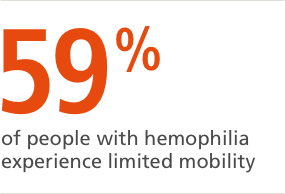
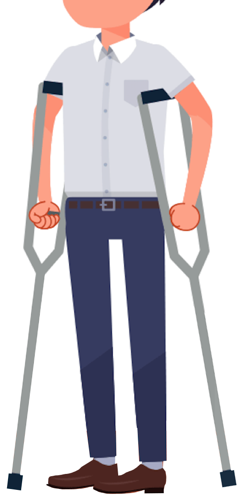
Experiencing reduced mobility?
You’re not alone.
Novo Nordisk conducted the HERO Study to find out how hemophilia affects people’s lives, including mobility. According to the study, 59% of people with hemophilia experience limited mobility.
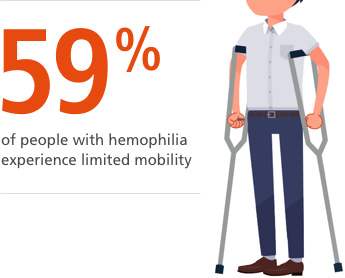
How do joint bleeds affect mobility?
A bleed can occur when a joint is stressed. This type of bleed is called an acute bleed, or hemarthrosis. When the same joint experiences repeated bleeding, the lining around what’s called the synovial membrane may become swollen and thick. This condition, known as “chronic synovitis,” can limit joint motion.
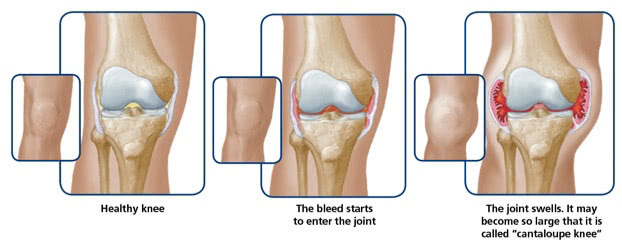
Long-term effects on joints
If bleeds continue, the joint’s bone surface starts to wear away. Rough edges of the bone tear the thickened synovial membrane. This process causes more bleeds and damage. Eventually, the joint gets bigger and may change shape or move slightly. When joint changes make it harder to move without pain or other problems, a person has progressive arthritis.
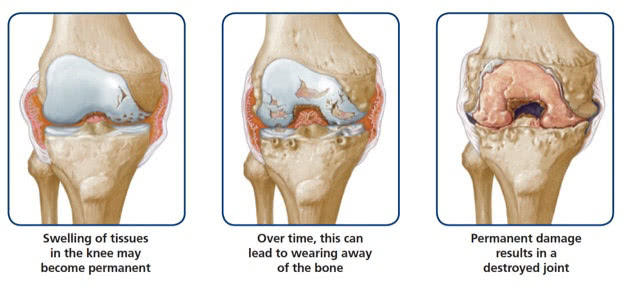
Once a joint is severely damaged, the body may not be able to heal itself. You may lose range of motion. You may even have a fixed joint that you cannot move at all. If range of motion becomes permanently limited, it is called hemophilic arthropathy. You may need to talk to your doctor about your options—including surgery.
Joints no longer healthy? Surgery may be an option.
Some people with hemophilia elect to have surgery to repair joints, relieve pain, and help them keep moving through life. Surgery can lead to less pain and more mobility, but there are risks. Talk with your family and your doctor to decide what’s right for you. Consider these questions:
How often do joint problems get in the way of your daily life?
How much pain do your joints cause?
Do you have insurance?
Can you commit to demanding physical therapy?
What are your personal goals?
Be sure to discuss the risks and benefits of elective surgery with your doctor.
Moving through life.
Learn how to transition through various stages of life with hemophilia, from self-infusing to going to college.
Building community.
Get tips on building a strong support system—an important component of living with hemophilia.
Moving through life.
Learn how to transition through various stages of life with hemophilia, from self-infusing to going to college.
Building community.
Get tips on building a strong support system—an important component of living with hemophilia.
